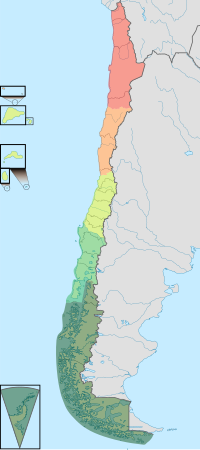Zona Sur

Zona Sur (Southern Zone) is one of the five
Geography
Although many lakes can be found in the Andean and coastal regions of central

The lakes in this region are remarkably beautiful. The snow-covered Andes form a backdrop to clear blue or even turquoise waters, as at Lago Todos los Santos. The rivers that descend from the Andes rush over volcanic rocks, forming numerous white-water sections and waterfalls. Some sections still consist of old-growth forests, and in all seasons, but especially in the spring and summer, there are plenty of wildflowers and flowering trees. The pastures in the northernmost section, around Osorno, are well suited for raising cattle; milk, cheese, and butter are important products of that area. All kinds of berries grow in the area, some of which are exported, and freshwater farming of various species of trout and salmon has developed, with cultivators taking advantage of the abundant supply of clear running water. The lumber industry is also important. A number of tourists, mainly Chileans and Argentines, visit the area during the summer.
In terms of
Climate
The climate of Southern Chile is rainy with a Mediterranean precipitation pattern.[2] The windward slopes of the Chilean Coast Range and the Andes receive up to 3000–5000 mm of precipitation annually.[2] Behind the Chilean Coast range there is a weak rain shadow while behind the Andes, in Argentina, precipitation drops sharply.[2] The zone lies in the mid-latitudes and is strongly influenced by the Westerlies.[2] During the summer the South Pacific High moves into the area.[2]
Soils
The main agricultural soils are;
Flora and fauna
The natural vegetation of Southern Chile is mainly the
A number of small mammals inhabit Southern Chile including the
History
At the time of the Spanish arrival beans, maize and potatoes are known to have been cultivated in Valdivia and around Bueno River.[9] The cultivation of beans extended likely all the way south to Chiloé Archipelago.[9]
Southern Chile was during the time of Spanish conquest and colony populated by indigenous
Demographics
Spanish is widely spoken in all the region, but the southern people speak a bit slower than Santiaguinos. In the Araucanía region, the Mapudungun is used in rural communities, especially between elders. German is widely spoken in the region because of German colonization, but mostly as a second or third language.
Gallery
-
Cattle grazing in the Rupanco area.
-
Cattle grazing near Llanquihue Lake. Osorno Volcano in the background.
-
Haverbeck Canal
-
The maritime influence of some southern Andean valleys makes them prone to snow falls in winter such as in Curarrehue in the picture.
-
Calle-Calle River in picture is one of various large rivers that drain the Andean lakes of Zona Sur.
References
- ^ S2CID 135109592.
- ^ ISBN 0-300-06423-3
- ^ Estudio de suelos de la provincia de Valdivia (in Spanish). Santiago: Instituto Nacional de Investigación de Recursos Naturales – Universidad Austral de Chile. 1978. p. 1.
- . Retrieved January 12, 2019.
- ^ Schlatter et al. 2003, p. 100.
- ^ a b Schlatter et al. 2003, pp. 92–93.
- ^ a b c d Hernández, Silvia (1973), Geografía de plantas y animales de Chile (in Spanish) (2nd ed.), Santiago de Chile: Editorial Universitaria, pp. 130–165
- . Retrieved 21 January 2024.
- ^ ISBN 9789569120022.
- Bibliography
- Schlatter, Juan; Grez, Renato; Gerding, Víctor (2003). Manual para el reconocimiento de suelos (in Spanish). ISBN 956-7105-25-1.







